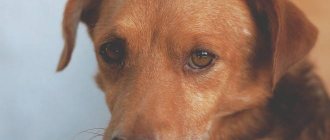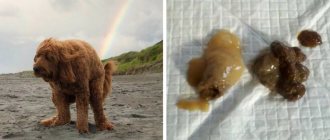Causes of illness
Dog with toilet paper
There are many reasons why a dog has vomiting and diarrhea. It is almost impossible to make a diagnosis on your own, and therefore it is recommended to immediately consult a veterinarian. After all, severe dehydration can ruin a dog’s health.
The causes of vomiting and diarrhea may be:
- with one-time or short-term vomiting - overeating;
- if you vomit several times - poisoning;
- vomiting with foam and blood - a foreign body in the pet’s nose or throat;
- transition to a new diet;
- vomiting after feeding - worms;
- lack of appetite and vomiting in a puppy - parvovirus enteritis;
- inflamed eye mucosa - rotavirus infection, adenovirus;
- chemical poisoning.
These types of eating disorders occur quite often in dogs. Treatment at home can be carried out if the dog does not have serious illnesses, and the clinical picture does not contain other alarming symptoms.
Note! Consultation with a veterinarian is necessary if the dog belched several times before vomiting or if there was bile or white foam in the vomit.
If your pet has bloody diarrhea mixed with mucus, you should quickly seek medical help, as this may be a symptom of the following diseases:
- atypical form of rabies;
- gastrointestinal ulcers;
- pancreatitis;
- cancer, tumor;
- intestinal infections;
- parvovirus enteritis;
- helminthiasis;
- dysbacteriosis;
- poisoning
The owner should be alerted to changes in the animal’s body temperature, the color of feces, the presence of impurities in them, and the unpleasant smell of the discharge. Your pet's stool should be brown even with diarrhea. Color change may occur for the following reasons:
- Black stool indicates internal bleeding in the gastrointestinal tract.
- White feces imply that bile cannot leave the body, which can lead to the conclusion that the pathways through which it exits are blocked.
- Green excrement is released in the event of fermentation, the development of putrefactive processes in the intestines, as well as during a viral infection in the animal.
- Orange stool occurs with liver dysfunction.
- Yellow excrement indicates problems with the gallbladder, liver and a number of diseases.
For reference! The reasons for the change in the color of stool may be the foods that the pet ate. Natural dyes include beets, carrots, activated carbon, and blood sausage.
Dog with carrots in teeth
Necessary actions for diarrhea and vomiting
An experienced specialist, as well as a person who is not the first to encounter a similar phenomenon in dogs, can cure an animal at home. If diarrhea is not complicated by other factors, then sorbent agents will help remove toxins from the body. It is recommended to use veterinary drugs in the dosages specified in the instructions for use. It is not advisable to use human medicines because they have not been tested on animals.
The owner must ensure that the pet adheres to a certain diet. In the first couple of hours after vomiting, it is not recommended to give the animal anything to drink. Subsequently, you can give 20 teaspoons of clean water every 20-30 minutes. As soon as your pet stops drinking, you should stop trying. Excess fluid in the body can cause repeated vomiting.
If the dog continues to diarrhea, it is worth giving it compounds that will maintain the level of fluid in the body, which comes out along with feces and vomit. If a pet has a helminth infestation, it is necessary to treat it with deworming medications, strictly following the dosage specified in the instructions for use.
Important! Diarrhea is only a symptom of another disease, and therefore, before you begin to treat the animal, you need to find out the reason that caused the diarrhea.
Due to age, diarrhea is more common in puppies than in adults. This is due to the immaturity of the baby’s stomach. Many dog owners who encounter their pet’s abnormal stool for the first time do not know what to do. First of all, you need to pay attention to the frequency and color of diarrhea (yellow, black, green or bloody are not normal).
If diarrhea is not complicated by a change in the color of the stool, as well as the frequency of bowel movements, then you just need to change the puppy’s diet. In the first few hours after the onset of diarrhea, you should not feed him, give him only water or rice broth. On your doctor's recommendation, you can feed your dog activated charcoal.
Feeding a dog activated carbon from a syringe
Why does vomiting occur?
The formation of foam in the stomach of an animal is considered a natural process. The inside of the stomach is protected by special mucus. There are also remains of digestive juice there. All this actively interacts with oxygen, which the dog swallows, after which foam is formed. Gastric juice gives it a yellowish tint. Due to the penetration of bile into the foam, it acquires a pronounced bright yellow color. Vomiting in dogs can be due to several reasons, which signal not only dangerous diseases, but also natural physiological processes.
Unfortunately, the animal cannot tell its owner how it is feeling. Therefore, the owner learns that the pet is vomiting by the following sign:
- the dog refuses water and food;
- licks his lips frequently;
- the dog is restless and moves chaotically;
- the dog begins to salivate profusely;
- constipation or diarrhea;
- loud belching and rumbling in the stomach.
Diet for disorders
If your dog has diarrhea and vomiting, you will need to put him on a special diet. Before a specialist arrives, it is necessary to monitor the pet’s condition, as well as the nature of the discharge. Diagnosis depends not only on the qualifications of the veterinarian, but also on the attentiveness of the animal owner. The specialist will draw up an analysis not only based on what he saw, but also by asking the owner about the type of vomit, frequency and nature.
Side symptoms play an important role. This includes the general condition of the animal, its appetite, abdominal condition, thirst or refusal of water. Every dog owner should know what to do if a dog is vomiting and has diarrhea.
Attention! First of all, you should take care of the presence of fresh water in a bowl to which the animal has access.
It is not recommended to feed your pet, since many types of food can irritate the sensitive mucous membrane of the dog’s stomach. If the dog is healthy and has a normal appetite, he will absorb food, despite gastrointestinal irritation and further vomiting.
Eating for an upset stomach
In the first 12 hours after the onset of vomiting and diarrhea, it is necessary to provide unloading to the pet’s gastrointestinal tract. Complete rest will help remove excess sensitivity and irritation of the mucous walls of the stomach. At this time, any food is excluded, only water should be constantly available.
On the second day, you can give your pet rice water, and then the porridge itself. If the dog gets better, then you can subsequently give low-fat light food for 3-4 days. The diet should consist of fermented milk products, rice and buckwheat porridge, boiled chicken, eggs and sea fish.
Food must be finely chopped and given in small portions several times a day. All foods must be warm. You should not include vegetable oil or milk in the menu, as they relax the intestines, which aggravates the situation. To restore the gastrointestinal tract, it is necessary to use high-quality, but not fatty, fermented milk products.
Note! Vomiting leads to dehydration of the pet's body. This process can cost the animal its life, and therefore it is necessary to provide assistance and provide it with drink.
If necessary, the veterinarian can administer an intravenous infusion of a maintenance solution.
Dog drinks water
When you don't need a doctor
Manifestations that do not require contacting a veterinarian:
- Foreign object in the stomach (not to be confused with intestinal obstruction).
- Hunger.
A dog vomiting yellow foam in the morning is considered common and normal. This symptom appears after a long break between meals. The animal thus gets rid of excess gastric juice, which accumulates in anticipation of food. If your dog burps once a month and feels fine, there is no reason to worry. The owner should feed his four-legged friend more often, or review his menu.
A foreign object could be a ball of hair, a pebble, a piece of a toy or a bone that was accidentally swallowed the day before. Owners notice that during a walk the dog searches for grass, thereby causing itself to vomit. There is no need to drive the dog away from the plants. After vomiting, you can find a foreign object in the foam - the pet’s body itself has gotten rid of the trouble.
Diagnostics
If you need to go to a veterinary clinic, the doctor will conduct a series of tests. Initially, compiling an anamnesis involves interviewing the owner to clarify a number of nuances regarding the time of onset of vomiting and diarrhea, the condition of the animal during the process, feeding, and other things. The specialist will need information about the medications that were given to the pet.
After this, the veterinarian must conduct an external examination, measure the animal’s body temperature, and also listen to its lungs and heart. If you have difficulty making a diagnosis, you will need to do a series of tests. These include:
- general blood analysis;
- blood chemistry;
- polymerase chain reaction;
- urine density;
- protein content in urine;
- stool examination for parasites and occult blood.
The results of these studies will help to find out the reason why the dog started experiencing nausea and diarrhea and determine the severity of the pet’s condition.
Additional Information! If there is a suspicion of the presence of foreign objects, damage to the mucous tissues of organs, as well as tumor neoplasms, additional studies will be required: x-rays and ultrasound.
Diagnosis by a doctor
Veterinarian visit and treatment
To make a diagnosis, you will need to take blood and urine tests, as well as undergo an ultrasound and x-ray. Depending on the results, the veterinarian may order other laboratory tests to identify the pathogen and where the problem is occurring.
Depending on the cause, the four-legged patient is prescribed the following treatment options:
- Medication
. To eliminate the root cause, medications are prescribed aimed at eliminating the pathogen (anthelmintics, antibiotics, antivirals). Additionally, symptomatic treatment is carried out to eliminate the consequences of the disease and normalize the functioning of internal organs.
- Surgical
. If the intestines are blocked or an intestinal loop is compressed, the animal undergoes surgery. The surgeon removes the stuck object, cuts out tumors, eliminates suppuration and dead tissue.
After treatment, the weakened body will need strength to recover. The work of immune cells is stimulated by taking vitamin complexes, and beneficial intestinal microflora is restored with the help of probiotics.
The usual diet is introduced gradually to avoid excessive stress on the stomach. The therapeutic diet involves fractional meals of easily digestible food. The dog is given chicken broth and rice water. Gradually, watery porridge, small pieces of boiled chicken and cottage cheese are added to the diet. All food must be fresh and warm. If you don’t have time to cook, buy medicinal wet food.
When emergency help is required
There are a number of cases where a dog has diarrhea and is vomiting, when you cannot self-medicate, as this can lead to complications and difficulty making a diagnosis. In these situations, it is necessary to urgently seek professional help. Inspection required:
- when body temperature changes;
- mucous discharge from the eyes and nose;
- in the presence of pain;
- hydrophobia appears;
- with diarrhea for more than 3 days.
It is also worth taking your pet to the vet if there are blood clots in the stool, or if the color of the excrement is different from normal.
Is it a deviation or not?
Normally, dogs defecate 2-4 times a day. In a small puppy, bowel movements are observed more often. This largely depends on your daily routine and routine, as well as your diet.
As a rule, feces have a formed shape and are light or dark brown in color.
The main symptom of indigestion is considered to be loose, watery stools. It contains foreign impurities.
Diarrhea refers to frequent bowel movements. This is a pathological condition in which stool acquires a tarry, porridge-like or watery consistency.
The color of stool can be very varied. It is possible that there may be foam, mucus, blood spots, or grains of undigested food in the stool.











